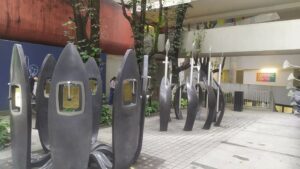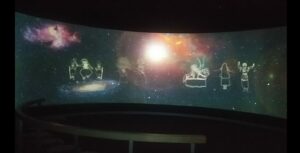India's first interactive museum lets you experience music at your fingertips and also lets you make your own music.

The museum is full of the history of various forms of music and different genres and artist. (Deeksha Devadiga/ South First)
I was never a museum person before, but this year alone I have visited at least five of them.
I am new to Bengaluru and I don’t have enough drinking buddies yet to visit the fantastic pubs this city has to offer. (I will, someday).
And when my editor assigned me to go to a music museum, I figured why not! I can’t say no to her.
Before visiting the Indian Music Experience Museum, I connected with CA Narayanan, who volunteers at the museum. Narayanan has been associated with the museum for the past five years and was kind to take time off of his busy schedule to give me a tour of the museum.
Two buses and two hours later from my home (in Whitefield), I was at the museum. The music experience begins right from the entrance.

You can experience different principles of sound at the Sound Garden. (Deeksha Devadiga /South First)
The Sound Garden was opened two years ago before the actual museum and it comprises 10 specially designed playable musical instruments.
The first thing after entering the museum, you are face-to-face with the nine rasa wall. And you get a brief introduction to music.
I stood mesmerised by the audio-video content, the beautiful transitions happening on the screen — the tour had just begun.

The introduction to music video keeps you engaged right from the beginning.(Deeksha Devadiga/South First)
The first gallery was called the ‘Contemporary Expressions’ and it was set up in such a way as to make it feel like any busy street in Bengaluru.
It had autorickshaws installed with mini-theatres in them. You can sit and relive the olden days of sitting in an abandoned auto with your friends.
The gallery also showcased India’s early independent days of Indie rock music. Also on display was a Daler Mehndi costume he had performed in.
What sets the museum apart is that it lets you experience the music through the interactive systems it has in all the galleries.
The museum provides you with a set of headphones, but you can also plug in your headphones or earphones and play your favourite band or music.
The second gallery was dedicated to Carnatic and Hindustani music and the influence of great musicians and poets from the 15th-century India.
The highlight of this gallery was the Samay chakra zone, where you can sit and witness time through music. It is very zen-like and makes you appreciate the little things in life.
A constant feeling I had throughout the tour of the museum was how it could get better. I kept getting better.
An everyday routine for me back when I was living with my parents was cooking dinner with my mom and our conversations would just flow. Sometimes I would start humming a song and she would complete it for me.
The third gallery — songs of people was a visual representation of that kitchen scene at my home. There are songs associated with birth, death, and everything in between, carried through generations.
The foreign influence introduced instruments such as the violin and harmonium to India. The fourth gallery was accurately named the ‘Melting Point’. The gallery had a violin and harmonium on display along with a grand piano at the centre.
I was not ready for the fifth gallery which followed. It had a stunning double-height display of over 100 different musical instruments from across the century. It had instruments shaped like birds and animals. It also included traditional instruments used in folklore and rural music.
The interactive tool allows you pick an instrument of your choice and experience playing the instrument with just simple clicks. Information on each of the instruments about its origin, making and playing techniques, was also available.
When I stepped out of the gallery, echoes of Jawaharlal Nehru’s famous speech (A tryst with destiny) on the eve of India’s Independence day could be heard. This museum section was dedicated to India’s freedom fighters and their love for music. It also included songs of protest and nationalism in popular culture.
Walking through all the different galleries, I released my knowledge of music is basically a big cipher: I had never listened to any of these indie rock bands or classical music. I grew up listening to Kannada Jaanapada songs, courtesy of my mom, who would teach me one song every year so I could perform at our community cultural program. I also grew up listening to old Bollywood and Kannada film songs from the 1990s and early 2000s.
I almost jumped in joy when I saw the next gallery dedicated to the landmarks and legends of Hindi film music. And another wall was dedicated to the legends of Kannada film music. It was my childhood in a nutshell. I cried. No lie.
They had a walk-through of the influence of music and instruments in films right from black and white to modern-day films.
Throughout the museum, many small musical notes — or silhouettes of instruments — made shadows. These small details make it engaging for small children said, Narayanan.
The eighth gallery was like walking down through the centuries. The different ways in which music had been consumed since the early gramophones, records, radios, CDS, microphones to ipods were displayed.
Recalling an incident from one of his tours with some school children, Narayan said, “I had a child ask me why is a microwave here pointing at an old radio on display.”
The last gallery had 100 luminaries in various genres of Indian music featured across the room. They also had memorabilia on display donated to the museum by some of the acclaimed musicians, such as the attire of Bhimsen Joshi (complete with his famous paan box), MS Subbulakshmi’s tambura, etc.
They also have a recording studio where you can record yourself singing and can also edit and customise it. The room is soundproof and I felt very much like a professional singer on the microphone. When I played it back, I realised why I was not a professional.
Right outside the studio, we met with Abby and David from Dublin who were visiting India for the first time and were in the city to attend a friend’s wedding.
Narayan who had lived in the US for 45 years stuck up a conversation with them which ranged from music to food to culture. Abby, a musician herself, had heard about the museum from a friend and wanted to visit it before returning to her country. She was awestruck by the 100 displays of instruments she mentioned in the conversation.
When you step out of the museum there is a learning centre where you can enroll yourself or your children to learn instruments from trained professionals. You can also volunteer at the museum. They have a cafe attached to the museum which makes it a perfect place for a cute first or second date — it will surely gain you some brownie points.

Jul 25, 2024

Jul 25, 2024

Jul 25, 2024

Jul 24, 2024

Jul 24, 2024

Jul 23, 2024